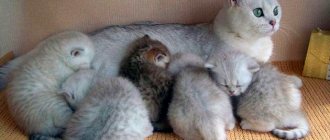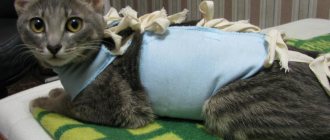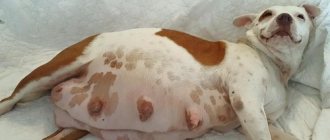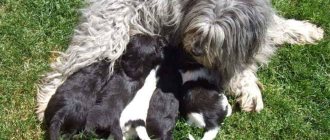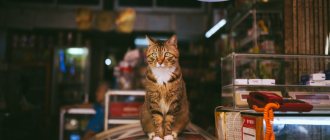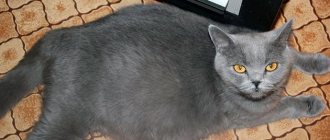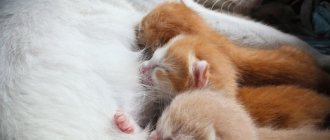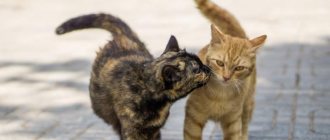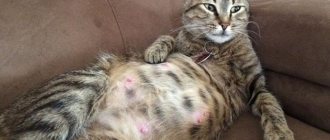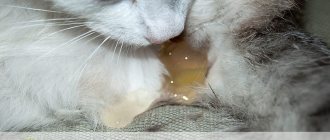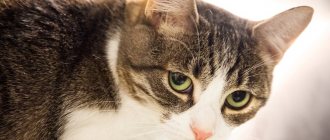Creating the right menu is not an easy task, and if your cat has recently given birth, you need to be even more careful when choosing products. 2-3 days after birth, the pet may have no appetite, but then it returns in double volume. Of course, during lactation the female loses a huge amount of proteins, fats, vitamins, minerals and carbohydrates, and this can only be replenished through food.
Food for a nursing cat should be: nutritious, balanced, fresh. It is better to give the animal food heated to 30-32 degrees. If earlier you fed your pet 1-2 times a day, now the number of feedings needs to be increased to 4-6 times. In the first week, the nutritional value of the diet should increase by 10%; under no circumstances should you overfeed.
General recommendations
Newborn kittens cuddle with their mother almost every two hours . Together with milk, they “suck” calcium, vitamins, and a lot of microelements from the nurse. Due to this, they grow and develop. But in order for mother not to lose weight and not lose her beauty, she must constantly make up for all these losses. This can only be done through a special diet - enhanced and balanced. Therefore, the food of a nursing cat should be rich in proteins, fats, carbohydrates, and rich in calcium, minerals and trace elements.
This is interesting! The cat actively feeds her kittens until about 2 months of age. At this time, she spends 3-4 times more energy than usual.
During lactation, the cat is fed frequently and in small portions. Essentially, her feeding pattern becomes similar to that of kittens. His main principle at this time is to provide the mother with regular replenishment of energy reserves so that she does not feel hungry. But food should not only be nutritious, but also varied, easily digestible, enriched with vitamins and contain a sufficient amount of liquid.
Healthy eating rules
The rules for healthy cat nutrition before and after birth are similar. Only small adjustments are needed to take into account the peculiarities of the new status - a nursing mother.
Nutrition during this period has 3 tasks.
- Restore the animal's strength after birth.
- Stimulate milk production.
- Match the increased energy expenditure during the feeding period.
Moreover, the nutritional value of the food should be such that it is enough to replenish the body’s reserves for future pregnancies. And although this is achieved not only by increasing the volume of food, it is the volume that needs to be adjusted first.
The serving size and total daily ration during the feeding period depend on three factors.
- Litter quantity.
- The animal's own weight.
- Age of the animal.
Important! On average, it is believed that a lambing cat needs 2 times more food.
It has been noticed that some cats do not eat well immediately after giving birth. Their taste preferences often change. They refuse their usual food and begin to enjoy eating raw fish and drinking milk, which they had previously resolutely refused. Owners should be understanding about such “zagidons”, trying to add more variety to the nursing mother’s diet so that the animal’s appetite is always at its best.
The first two weeks after childbirth, the nurse's menu is made up of easily digestible foods - milk, cottage cheese, vegetables, cereals and boiled lean meat. The second half of the feeding period is marked by a transition to “usual” foods.
The diet becomes more meat and fish. Throughout active lactation, the cat needs plenty of fluids and increased replenishment of calcium and magnesium. Their deficiency is fraught with problems with teeth, joints, and hair in a nursing mother.
As a result, the proper nutrition of a nursing cat will be determined by its appearance and weight after this important and stressful stage is completed. Ideally, after the kittens gain independence, the animal should weigh the same as it weighed before pregnancy and look no worse. And well-fed, healthy offspring will frolic nearby.
Natural nutrition
The diet of a nursing cat can consist of both special industrial food and dishes prepared by the owner himself. If in ready-made food all the proportions have already been verified and balanced by the manufacturer, then, with natural nutrition for the ward, its owner will have to perform these tasks himself.
There are several rules for natural nutrition of a nursing cat:
Stimulation of lactation.
- During the first 25 days after birth, a cat's milk is intense. Then its quantity decreases. Sometimes, even with good nutrition, it is not produced enough. Therefore, we need products that stimulate lactation. These are usually milk and broths. For greater effect, they add decoctions of herbs - anise, lemon balm, oregano - a teaspoon in the morning and evening. You should take into account the cats’ delicate sense of smell and make a decoction of low concentration (1 teaspoon of herb per 3 cups of boiling water). The broth should not be bitter.
Freshness and naturalness.
- All products must be fresh and free of chemical additives.
The presence of protein products in the diet.
- These are sea fish, chicken, turkey, beef, liver, eggs. All this is given boiled.
Presence of carbohydrate components.
- They are provided by cereals in the form of porridges. Buckwheat, oatmeal, and barley cereals are good.
Dairy products.
- Cottage cheese, goat's or cow's milk - they should make up at least 1/3 of a nursing mother's menu and be given 3 times a day.
Vegetables.
- They are added in a crushed state to porridge soup that has cooled to room temperature. Suitable for these purposes: pumpkin, lettuce, cucumber, Chinese cabbage, carrots, broccoli, cauliflower. Problems may arise if the animal has not previously been accustomed to vegetables. Refusal of vegetables is a reason to grind them in a blender and try to start mixing them into food, a teaspoon at each meal, gradually increasing this amount.
Vitamin supplements.
- You can give specialized industrially produced vitamin supplements, or you can add sprouted grains of wheat, oats, millet to food, or give your cat grass grown from these grains.
This is interesting! A convenient option is half porridge and half soup. To prepare it, add cereal to meat or fish broth (with pieces of meat/fish) and boil it properly.
Wet economy options
Felix
Price from 19 rub. per bag.
Food from Purina. The composition contains 4% meat components, vegetable protein extracts, an unknown amount of fish, unknown sugars, thickeners, vitamins.
Felix kitten food
Gourmet
Price – from 25 rub. per pouch package, from 35 rub. per jar.
Canned food from Nestlé Purina is produced in pouches and small portioned tin cans.
The composition of the product is almost identical to Felix, but the price is an order of magnitude higher, especially for canned pates. The owners note that kittens love spiders, but most likely this is due to the flavorings.
Gourmet kitten food
All Cats
Price – from 16 rub. per bag.
Contains 20% minced chicken, 4% meat by-products, an unspecified amount (less than 4%) of fish by-products, vegetable proteins, flaxseed oil. At this ratio, the food is liquid and smells very strongly of fish, which suggests the use of flavorings.
All Cats kitten food
Whiskas spiders
Price from 22 rub. per bag.
The ingredients on the bag are extremely difficult to read. Armed with a magnifying glass, you can make out that the food consists of 45% meat and offal (chicken min. 4%), the manufacturer has classified the rest of the proportions, indicating vegetable oil, cereals, antioxidants, taurine, vitamins, and minerals.
kitten food Whiskas spiders
Sheba
Pouch price – from 38 rubles.
Wet food for kittens Sheba, from Mars. Manufacturers produce entire collections of Sheba flavors with attractive names, positioning their foods as premium.
But the composition of the spiders is no different from the bags of economy options. The same base of offal, unclear ratio of grains and flavoring additives.
Sheba kitten food
Products for nursing cats
The diet of a nursing cat must include foods rich in protein and calcium.
- Protein . The main building material of cells. If the mother cat does not receive enough of it, her milk will be inferior, which means the kittens are at risk of rickets, slow growth and exhaustion.
- Calcium . A mineral responsible for the condition of hair and teeth. Its deficiency can provoke muscle spasms, convulsions, cause rickets and even lead to the death of the animal.
Important! Protein is found in meat, fish, eggs, dairy products, legumes, cereals, and various vegetables.
Calcium-rich foods that should be included in the diet of a nursing cat are milk, fermented milk products, salmon, sardines and white cabbage.
What can you feed
A nursing cat can and should be fed everything that actively replenishes its supply of proteins, fats, carbohydrates, microelements, and vitamins. It’s easier to do this using ready-made industrial feeds - everything is already balanced there, and the dosage is indicated on the packaging. But some breeders and their pets prefer natural food.
It will also be interesting:
In this case, the diet of a nursing cat mother should include: sea fish (salmon, sardines), eggs (chicken, quail), fermented milk products (cottage cheese, yogurt, kefir, cheese), legumes (peas, lentils, soy), meat ( beef, veal), poultry (chicken, turkey), cereals (buckwheat, rice, oats), vegetables (carrots, cabbage).
What not to feed
List of 8 foods prohibited for a nursing cat:
- River fish is less digestible and can be infected with parasites.
- Raw meat is poorly digestible and creates additional stress on the digestive system during the intense postpartum period of lactation.
- Pork is excluded due to its high fat content.
- Salty, spicy, sweet - everything that is unnatural for a cat’s diet is “ugly”.
- Sausage, smoked meats - a lot of fat, salt, preservatives. There is little benefit, much harm.
- Potatoes are not digestible in any form, either raw or boiled.
- Bones (fish, bird) are dangerous and therefore contraindicated.
- Flour and butter are empty carbohydrates, no nutrients, only the threat of diabetes and obesity.
Diet
As long as the mother cat is feeding her kittens, she is free to eat as much as she wants and whenever she wants. Usually, this is 4-6 times a day instead of the usual two. The owner is only required to ensure that the bowl is filled and the daily amount is evenly distributed.
The portion size for natural feeding is selected experimentally, based on the size and appetite of the nurse, as well as the number of her offspring.
Economy class dry food
Friskies
Price – 94 rub. for 400 g.
Dry food from Nestle Purina PetCare Compan (USA). One of the most budget products with a poor and unclear composition, which is based on by-products in an unknown proportion. The food attracts with its very low price, constant availability in any mass market and active advertising.
Ingredients: cereals, animal products (unknown parts of chicken), vegetable oils, yeast and plenty of preservatives.
for kittens Friskies
Whiskey Special
Price – 106 rub. for 350 g.
Product from Russian. The composition predominates in flour of animal origin, wheat, and poultry. Animal fat, sunflower oil, brewer's yeast.
A good mineral and vitamin complex is declared. The manufacturer does not indicate the exact content of the declared components; one can only guess about the amount of meat in the food.
for kittens Whiskas Special
Purina One
Price from 93 rub. for 200 g.
Purina One is a dry food from Nestlé. According to experts, it is in the middle between the economy class line and premium food.
The manufacturer indicated the percentage of content. In first place is 15-17% meat or salmon content, then, in descending order, wheat (a source of carbohydrates), dry poultry protein, corn, soy flour. Not a bad ratio of useful additives.
for kittens Purina One
Purina Cat Chow
Price – 134 rub. for 400 g.
Another product from the Purina line. The composition is slightly worse than in Purina One, so this is a solid economy option.
Cereals come first, without specifying the percentage. Next, 33% of incomprehensible “meat and meat products”, products of processing of vegetable raw materials, proteins and fats.
kitten food Purina Cat Chow
Stout
Price – from 103 rub. for 300 g.
Russian product from. A very dubious composition, based on bird meal from unknown parts of the bird.
Carbohydrate sources include wheat, corn and rice, which are not ideal for sensitive gastrointestinal tracts. There are very few vitamins.
kitten food Stout
Our Brand
Price – 91 rub. for 400 g.
Also a product from Gatchina KKZ, the quality is worse than Stout. Food based on vegetable protein and poultry meal. Added hydrolyzed liver in an unknown proportion, brewer's yeast and sunflower oil. There are few valuable additives, there is a mysterious antioxidant.
kitten food Our Brand
Cat health during lactation
Pregnancy, subsequent childbirth, and then feeding the offspring - all this is a huge burden on the mother cat’s body.
And loads are often fraught with stress and exacerbations of chronic diseases, decreased immunity and inflammatory processes.
This is interesting! Among the most common diseases during lactation is mastitis.
This inflammation of the breast occurs from a small wound or crack into which a pathogenic bacterium enters. Mastitis can provoke stagnation of milk when a cat has few kittens and the milk remains unclaimed.
List of prohibited components
Your cat's diet should not include:
- River fish. There may be parasites in it.
- Raw meat. It is almost not absorbed and overloads the animal’s already weakened body.
- Pork.
- Salty, spicy, sweet.
- Sausages.
- Potatoes in any form.
- Bones.
- Muffins.
Due to the increased load on the cat’s body, in addition to an increase in the daily volume of incoming food, the number of its intake also changes. Instead of the usual two, the pet can eat up to six times a day. The owner’s main task during this period is to monitor the quality of the food and consult a veterinarian on any questions that arise.
A secluded place for a cat after giving birth
The postpartum nest is placed in a dark place, away from noise and prying eyes. It must be protected from drafts from all sides. It is recommended to select bedding in light colors so that it can be changed immediately when dirty. If the room is cool, you need to place a heating pad with warm water or a special electric heating mat in the house.
After giving birth, the cat needs special attention
Attention! Food, water and a tray should be placed near the house. This is necessary so that the new mother does not leave the kittens for a long time. Drinking water should always be clean and at room temperature.
The house can be bought or made from a cardboard box
Psychological comfort
In order for the pet to feel safe, the mother and kittens should be kept in a quiet room where family members (except for the one watching the litter and the pet) should not enter unless necessary. Children and guests should not be allowed to touch the kittens, as a worried cat may believe that her babies are in danger. In such situations, the cat’s behavior can be unpredictable: the milk will disappear, or the pet will drag the kittens to a secluded place and hiss at everyone who wants to approach. Sometimes particularly nervous cats even destroy the offspring, believing that it is impossible to raise it under these conditions.
Diet
For the first 4-5 hours after giving birth, the cat will refuse to eat. She needs to be offered warm water and milk.
Meat products
Immediately after childbirth, you can introduce a small amount of boiled dietary meat (turkey, rabbit) into your diet. From the 14th day, when the pet has fully recovered, the usual food is given. Including meat in any form.
Dairy
Dairy products are necessary after childbirth. What to feed a newborn cat:
Dairy products saturate the body with beneficial elements
Important! Dairy products must be present on the menu throughout lactation and 20-30 days after its end. After this, if the cat refuses, you can eliminate milk from the diet.
Bone flour
Contains calcium, which is necessary for the animal during the postpartum period. If there is a lack of it, the cat feels unwell, convulsions and eclampsia may occur. Such pathological conditions often lead to death. Bone meal should be given 1 tsp. daily. The Scottish Fold especially needs this so that the ears take the correct position.
Fish is necessary for a cat who has given birth, but not more than several times a month. It is better to give preference to low-fat varieties. What fish to feed a nursing cat:
The fish must first be cleaned of bones.
Broths
Warm broth improves the functioning of the gastrointestinal tract. It can be prepared from chicken, turkey, beef, cereals and vegetables, but without spices and salt.
Special dry food
For the first time after giving birth, it is not recommended to give your pet a ready-made dry diet. It contains virtually no moisture and adversely affects milk production. In addition, the food contains a lot of heavy salts, which is bad for growing kittens.
The only exceptions are purebred cats (for example, British cats). If before giving birth the pet ate dry food, changing the diet is undesirable.
When the product is not digestible, you can switch to canned food from the same manufacturer
Eating for more milk
You can ask your veterinarian what to feed a cat that has given birth to kittens to produce milk. He will give the necessary recommendations based on the individual characteristics of the animal.
Often, to improve lactation, a cat is given a decoction of lemon balm, oregano and anise, 1 tsp each. in the morning and in the evening. It should be slightly concentrated: 1 tsp. dried grass is poured with 500-600 ml of water.
Attention! Before giving the animal a decoction, you need to try it yourself. If it tastes bitter, you need to add a little sugar. Otherwise the cat will refuse him.
Holistic food
This is one of the varieties of super premium food, consisting of 100% natural products. Translated, Holistic means “whole.” Holistics are products of a new generation, high class and in a serious price category.
Acana
Price – 370 rub. for 340 g.
Canadian food of the highest class. The Wild Prairie option is suitable for kittens. Akana contains 75% natural chicken and turkey. There are no grain components, vegetable proteins, or artificial ingredients.
Grandorf
Price for 2 kg – 1500 rub.
Grandorf dry food is produced by the Belgian company United Petfood Producers NV. For kittens they offer the “Lamb with Rice” option.
Based on lamb, fresh chicken and brown rice. Contains fiber, beneficial additives and natural antioxidants.
Go Natural
Price – from 1176 rub. for 1.3 kg
Manufactured by the Canadian company Petcurean Pet Nutrition.
It is based on high-quality meat ingredients and offal. Does not contain grains. As with all holistic products, the manufacturer uses only natural preservatives.
The food is available at many pet stores. Reviews from owners are mostly good; everyone notes the economical consumption of the product.
Carnilove
Price – 385 rub. for 400 g.
Czech food from the company VAFO PRAHA sro The manufacturer honestly indicates the composition with the percentage (flour from meat, poultry and fish). The product is grain-free and enriched with a worthy vitamin and mineral complex.
The composition contains cranberries, apples, rosemary. One brand is suitable for kittens - “Healthy Growth”.
Farmina N&D
Average price – 380 rubles. for 300 g.
Produced by Farmina Pet Food in Italy, Serbia and Brazil. For kittens, the manufacturer offers grain-free dry food with chicken and pomegranate. Contains chicken fillet, herring, eggs, fatty acids.
Feeding kittens
Regardless of the breed, for the first 3-4 weeks after birth, kittens feed exclusively on mother's milk.
Kittens continue to nurse, but it's not enough
When to feed kittens after they are born is usually clear right away. They become restless and begin to lose weight. If babies do not gain 10 g daily, it is time to introduce complementary foods:
- meat. It is better to start self-catering with beef. When kittens learn to chew, the diet can be varied with turkey and chicken. It is advisable to give by-products no more than 2-3 times a week, replacing meat. This could be the heart, liver, lungs, stomachs;
- well-cooked vegetables. When feeding, you should not give only legumes, tomatoes and eggplants;
- cereals, except those containing large amounts of carbohydrates;
- eggs. Quail can be given whole. Chicken - only the yolk. In the first year of life, it is enough to feed 1-2 times a week;
- dairy products. They should not contain sugar or sweeteners. Sour milk should be low-fat. Brewer's yeast and eggshells crushed in a coffee grinder;
- wet food. Manufacturers of such products produce special lines for kittens. It is recommended to choose super-premium products.
Kittens need to be fed 4-7 times a day
Note! A cat's taste preferences may change after giving birth. You need to approach this with patience and understanding.
In conclusion, it should be noted that if you follow the above recommendations, your pet will quickly regain strength and the postpartum period will pass without problems. It is easy to understand that the right diet has been chosen for the animal: it does not lose weight, there is enough milk during feeding, the fur does not fade, the kittens look happy and well-fed.
Related products
- Taking care of your digestion
Buy Now
- Kidney care
Buy Now
- Neutered cats are three times more likely to gain excess weight and develop bladder stones. Hill's Science Plan Sterilized Cat Young Adult promotes harmonious development and meets the specific needs of sterilized cats. Contains a complex of clinically proven antioxidants and a unique weight control formula. The unique Weight Control Formula helps burn fat and strengthen muscles. Controlled levels of minerals to support urinary tract health. Easy-to-digest ingredients for optimal absorption. High quality ingredients. 100% guarantee of quality, consistency and taste.
Buy Now
- ADULT CATS (from 1-7 years), ADULT CATS (from 1-7 years)
Buy Now
What is the best way to feed a cat after giving birth?
In no case should the animal's diet contain products containing chemicals. That is, it is forbidden to give your cat sausages, sausages, smoked fish.
It is not very good to feed her with cheap, low-quality store-bought food made from food waste, with the addition of flavor enhancers and flavorings. The best option is a gradual transition to professional, high-quality food designed specifically for nursing animals. Please note that you need to gradually transfer your cat to this diet: due to a change in food, her appetite may temporarily worsen, and some animals even refuse to eat.
We feed our pets exclusively with high-quality and proven Acana food.
Please also pay attention to the fact that during lactation it is undesirable to often give dry food to the animal. This is due to the fact that his need for water increases. And dry food increases this need almost threefold. This is why it is advisable to purchase ready-made wet food. It also contains almost all the essential nutrients. The amount of such food should be adjusted depending on the weight of the cat and its breed.
An excellent option for feeding a cat during lactation is Superpet natural raw food. This is the modern generation of ultra-premium cat food, consisting of pieces of fresh meat, egg yolks, offal, as well as vegetables, with the addition of omega-3, taurine, and vitamins. It contains no preservatives or flavor enhancers. It improves the health and digestion of cats, preventing urolithiasis, kidney disease and other health problems caused by consuming low-quality commercial cat food.
Natural raw food is also recommended for castrated and sterilized animals. Read more about their proper feeding in these articles - what to feed a neutered cat and the best food for sterilized cats.
Of the natural products, those mentioned above are preferable. For constipation, you can give a little warm milk and add a small amount of vegetable oil to your food.
Why does a cat need calcium?
Creating a menu for a nursing pet is not an easy task. Many owners, not knowing what to feed a nursing cat, give it food that is not quite suitable, which causes its hair to fall out, its teeth to deteriorate, and the quality of its milk deteriorates. And all because there is not enough calcium in the animal’s diet.
A cat's need for this mineral increases several times during lactation. Adding dairy and fermented milk products to the diet solves the problem of calcium deficiency in the body. They help provide the growing kittens with everything they need.
Additionally, you can consult a veterinarian to solve the problem of a complete and calcium-rich diet. However, to ensure your cat has enough calcium in her diet, only give her whole milk if she is not having diarrhea.
Features of choice
Just like for a small child, the first year of life is very important for a kitten, when bones and muscles are formed and future health is laid. If you feed your small pet correctly, it will grow up healthy and develop immunity to various diseases. He will develop correctly, become strong, and his coat will be beautiful and shiny. If it is a hairless cat, it will have healthy skin.
Veterinarians recommend feeding the kitten with specially selected food of high quality; it is believed that this is how the baby will receive everything necessary for its proper development. In the future, such a kitten will switch to food for adult cats.
Despite this, some owners believe that it is wiser to accustom the baby to human food. And then the cat will eat everything, and there will be no problems with nutrition.
What to give a cat to increase lactation?
To make your cat produce more milk, there are effective and harmless natural remedies. Here are some of them:
⦁ Infusion of walnuts with milk. To prepare this infusion, you need to put 8 - 10 peeled nuts in a thermos, pour 0.5 liters of boiling milk over them and leave for up to 4 hours. You need to add a little sour cream to this infusion and let it turn sour. The result is a very tasty yogurt that your pets really like. To strengthen the strength of the cat’s body after the release of colostrum, you can add two to three quail eggs, one to two teaspoons of glucose, and one tablet of medical yeast to this mixture.
⦁ Powdered nettle inflorescences are added little by little to cat food.
⦁ A decoction of wild raspberry leaves not only increases lactation, but also helps expel parasites, which is very important for nursing cats.
⦁ Green oat grass stimulates lactation, improves immunity and strengthens the animal’s body.
⦁ Infusion of lemon balm leaves in milk increases the quantity and quality of milk.
⦁ Herbs that increase milk production also include fennel, cumin, primrose, sweet clover, carrots, dandelion, and yarrow. You can make decoctions and infusions from them and give them to cats.
In addition, to increase milk supply, the cat needs rest, plenty of fluids and a balanced diet.
Pros and cons of eating afterbirth
Each kitten develops in an individual “pouch” - the placenta, which is expelled after the kitten. Instinctively, the cat breaks the bladder, stimulates the opening of the lungs, gnaws the umbilical cord and eats the afterbirth. The tissues of the placenta contain a lot of moisture, protein, vitamins and stimulants.
Many breeders are against eating afterbirth, arguing that it may cause indigestion. This reasoning is very sound when it comes to “problem” or “man-made” breeds, such as Scottish Fold cats. Stronger, and especially “noble” cats should not be restricted.
Wild cats give birth to 2–4 cubs, but domestic pets have long forgotten these norms. It happens that the owner comes home, and his pet is lying on his favorite sweater and licking 7-8 kittens, all the afterbirths have been eaten. For prevention purposes, you need to give your pet unsweetened enterosgel and boiled lean rice as a natural absorbent.
Results
Cheap food with dyes and flavors will certainly “reflect” on the appearance of your pet. For example, the Maine Coon breed does not have any special taste preferences, and is not classified as picky.
If you give a nursing cat an economy class, goodbye to fluffy fur and shine, even to the loss of whiskers and weight loss of kittens.
Proper cat nutrition will definitely make itself felt - the kittens are not thin or restless, the nurse’s coat is not dull, and her body weight has not changed much. The ideal option is when a cat that has fattened its offspring shows on the scale its previous weight before pregnancy.
